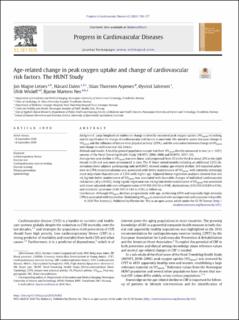| dc.contributor.author | Letnes, Jon Magne | |
| dc.contributor.author | Dalen, Håvard | |
| dc.contributor.author | Aspenes, Stian Thoresen | |
| dc.contributor.author | Salvesen, Øyvind | |
| dc.contributor.author | Wisløff, Ulrik | |
| dc.contributor.author | Nes, Bjarne | |
| dc.date.accessioned | 2021-03-31T07:54:41Z | |
| dc.date.available | 2021-03-31T07:54:41Z | |
| dc.date.created | 2020-11-09T21:02:39Z | |
| dc.date.issued | 2020 | |
| dc.identifier.citation | Progress in cardiovascular diseases. 2020, 63 (6), 730-737. | en_US |
| dc.identifier.issn | 0033-0620 | |
| dc.identifier.uri | https://hdl.handle.net/11250/2736172 | |
| dc.description.abstract | Background
Large longitudinal studies on change in directly measured peak oxygen uptake (VO2peak) is lacking, and its significance for change of cardiovascular risk factors is uncertain. We aimed to assess ten-year change in VO2peak and the influence of leisure-time physical activity (LTPA), and the association between change in VO2peak and change in cardiovascular risk factors.
Methods and results
A healthy general population sample had their VO2peak directly measured in two (n = 1431) surveys of the Nord-Trøndelag Health Study (HUNT3; 2006–2008 and HUNT4; 2017–19).
Average ten-year decline in VO2peak was non-linear and progressed from 3% in the third to about 20% in the eight decade in life and was more pronounced in men. The fit linear mixed models including an additional 2,933 observations from subjects participating only in HUNT3 showed similar age-related decline. Self-reported adherence to LTPA recommendations was associated with better maintenance of VO2peak, with intensity seemingly more important than minutes of LTPA with higher age. Adjusted linear regression analyses showed that one mL/kg/min better maintenance of VO2peak was associated with favorable changes of individual cardiovascular risk factors (all p ≤ 0.002). Using logistic regression one mL/kg/min better maintenance of VO2peak was associated with lower adjusted odds ratio of hypertension (0.95 95% CI 0.92 to 0.98), dyslipidemia (0.92 95% CI 0.89 to 0.94), and metabolic syndrome (0.86 95% CI 0.83 to 0.90) at follow-up.
Conclusions
Although VO2peak declines progressively with age, performing LTPA and especially high-intensity LTPA is associated with less decline. Maintaining VO2peak is associated with an improved cardiovascular risk profile. | en_US |
| dc.language.iso | eng | en_US |
| dc.publisher | Elsevier | en_US |
| dc.rights | Navngivelse 4.0 Internasjonal | * |
| dc.rights.uri | http://creativecommons.org/licenses/by/4.0/deed.no | * |
| dc.title | Age-related change in peak oxygen uptake and change of cardiovascular risk factors. The HUNT Study | en_US |
| dc.type | Peer reviewed | en_US |
| dc.type | Journal article | en_US |
| dc.description.version | publishedVersion | en_US |
| dc.source.pagenumber | 730-737 | en_US |
| dc.source.volume | 63 | en_US |
| dc.source.journal | Progress in cardiovascular diseases | en_US |
| dc.source.issue | 6 | en_US |
| dc.identifier.doi | 10.1016/j.pcad.2020.09.002 | |
| dc.identifier.cristin | 1846361 | |
| dc.description.localcode | This is an open access article distributed under the terms of the Creative Commons CC-BY license, which permits unrestricted use, distribution, and reproduction in any medium, provided the original work is properly cited. | en_US |
| cristin.ispublished | true | |
| cristin.fulltext | original | |
| cristin.qualitycode | 1 | |

